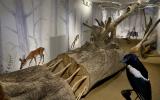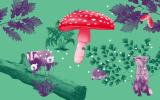At the heart of Pica’s Nest is a huge beech tree, with around 60 woodland animals hiding in its roots, trunk and leafy canopy. Some of the taxidermised animals are hidden in the tree, while others sit prominently on the branches. On the walls, you can spot loveable creatures created by the renowned children’s book illustrator Kathrin Schärer.
Pica’s Nest is an innovative new museum concept. It is a children’s exhibition tailored to the needs of our small visitors. However, it’s also a retreat for families, where accompanying adults can play with the children or enjoy a moment of peace and quiet. It’s named after Pica, the cheeky magpie who is the mascot for the Natural History Museum’s family programme. Here, you can do whatever makes you happy: children can enjoy unstructured play with their parents, other children or on their own; touch objects; give free rein to their urge to move around; and perhaps make a bit more noise than usual – all in a way in which everyone feels safe and comfortable.
An exhibition without any exhibition text
The Pica’s Nest concept is designed so that children are not overwhelmed with information; the exhibition does not aim to be educationally intense. Instead, children gather knowledge in a fun way: as they play, they discover more about the biodiversity of the forest. Children decide for themselves which animals they want to know more about. The objects have no labels – Pica’s Nest does not feature any exhibition texts. For those whose curiosity is piqued, however, there is a book filled with short, entertaining texts about all the animal species – children can read it themselves or have it read aloud to them. Thanks to the fun short texts, they’ll learn that the brimstone butterfly can freeze itself in winter or that the male robin knows up to 275 song melodies.
This forest experience was designed by the Natural History Museum’s education and design team in collaboration with the Swiss branch of the German company Kukuk, which builds unique play and activity spaces throughout Europe; Kukuk is also behind the popular playground in the Elfenau Park in Bern, among others.
A tree somes to the museum
The beech tree, which once towered at 35 metres, comes from eastern Switzerland. It had to be felled for safety reasons. Transporting and drying the tree proved to be a major challenge for the creators of Pica’s Nest. Due to its immense size and weight, the tree had to be sawn into several pieces, though these still boast impressive dimensions – for example, the root is more than two metres tall.

- Pica’s Nest is not supervised by staff. It is not a crèche. Parents or accompanying adults must not leave their child alone and must fulfil their duty of supervision as an accompanying adult.
- For safety reasons, please do not bring prams into the Nest.
- Preschools and schools are very welcome. However, Pica’s Nest is primarily aimed at visitors – for reasons of space, it is not suitable for school purposes. Schools and other institutions can reserve other rooms that suit their requirements free of charge on our website.
Exhibition credit
- Eine gemeinsame Ausstellung von/ Une exposition commune de
-
Naturhistorisches Museum Bern (NMBE)
KuKuk Freiflug und KuKuk Schweiz (KuKuk)
- Projektverantwortung/ Responsable de projet
-
Christoph Beer
- Ausstellungskonzept/ Conception d’exposition
-
NMBE: Jürg Nigg, Andrea Röhrig
KuKuk: Bernhard Hanel, Leander Dreissig
- Projektgruppe/ Groupe de projet
-
NMBE: Beatrice Baeriswyl, Christian Bähler, Christian Kropf, Constantin Latt, Jürg Nigg, Andrea Röhrig (Projektleitung), Stephan Schlup, Erich Stettler
KuKuk: Monika Göbel, Alexandra Komarovskaya, Vincent Wagner, Thomas Weber,
- Wissenschaftliche Begleitung/ Encadrement scientifique
-
NMBE: Christian Kropf, Hans-Peter Wymann, Manuel Schweizer
- Illustrationen/ Illustrations
-
Kathrin Schärer
- Szenografie, Realisation/ Scénographie, réalisation
-
NMBE: Jürg Nigg, Andrea Röhrig
KuKuk: Leander Dreissig, Thomas Weber, Vincent Wagner
- Bauleitung/ Direction des travaux
-
NMBE: Jürg Nigg, Andrea Röhrig
KuKuk: Leander Dreissig, Thomas Weber, Vincent Wagner
- Bauteam/ Equipe de construction
-
NMBE: Markus Holzer, Stephan Schlup, Christian Wüthrich
KuKuk: Kay Börsch, Seraphin Egli, Florian Heugel, Pascal McGechan, Felix Rassmann, Hannes Rühler, Volker Stock, Silvio Tscharner
- Lichtplanung/ Conception des éclairages
-
NMBE: Christian Bähler
- Präparate/ Préparation des spécimens
-
NMBE: Fabian Neisskenwirth, Constantin Latt, Martin Troxler
- Texte/ Textes
-
NMBE: Andrea Röhrig, Martin Ryser
- Korrektorat/ Correction
-
NMBE: Regula Markwalder
- Textlayout/ Maquette du texte
-
NMBE: Thea Sonderegger
- Öffentlichkeitsarbeit/ Relations publiques
-
NMBE: Sonja Delz, Simon Jäggi
- Fotos/ Photo
-
NMBE: Hannes Baur (Insekten und Spinnen), Lisa Schäublin
- Mit freundlicher Unterstützung/ Avec l’aimable soutien de
-
- Verein des Naturhistorischen Museums Bern
- Sophie und Karl Binding Stiftung
- Paul Schiller Stiftung
- Ursula Wirz Stiftung
- DC Bank
- Coop
- Ebenfalls danken wir allen privaten Spenderinnen und Spendern
- Partner/ Partenaires
-
Wood and Art
Walo Sportbeläge
- Trägerschaft/ Institution responsable
-
Burgergemeinde Bern
- Wir danken!/ Avec nos remerciements à
-
Forstbetrieb Burgergemeinde Bern, Mischa Hiltensperger, Stefan Hertwig, Katharina Lienhard, Fredy Reusser, Sg.kath.ch Forstbetrieb, Christine Studer, Marcel Studer,Tagesstätte Bern West, Daniela Vacas, Marlis Zaugg

